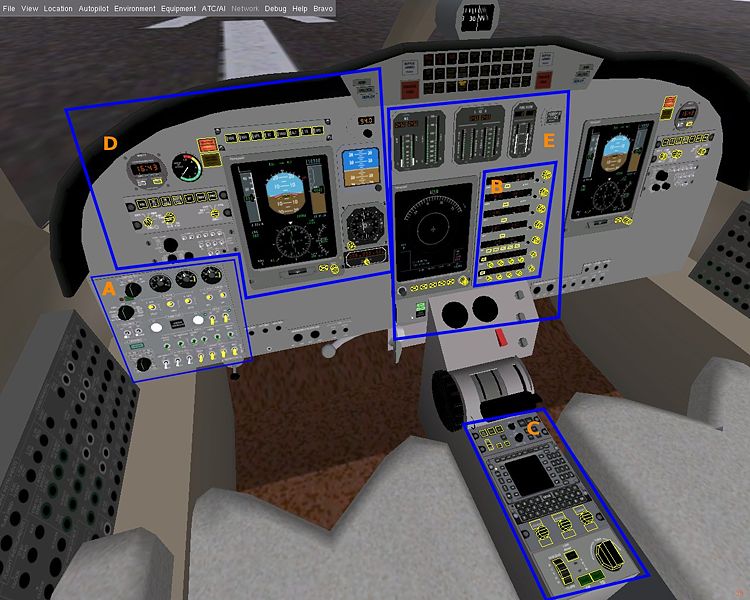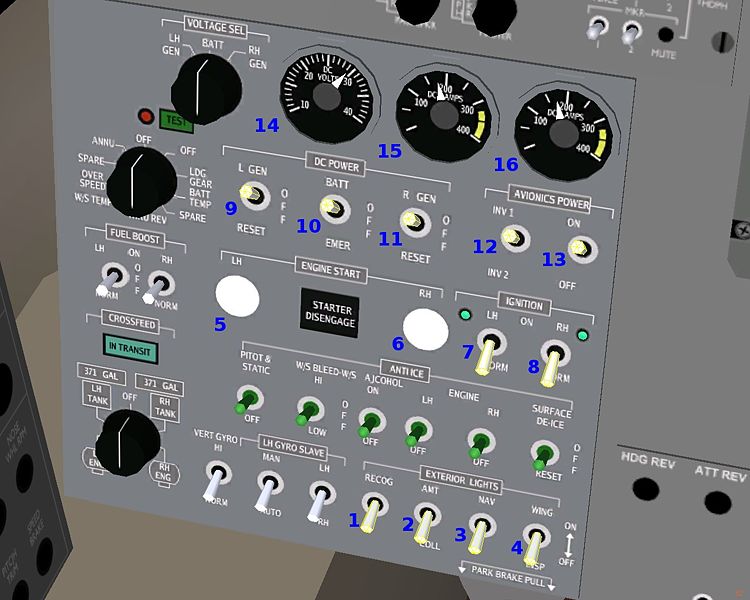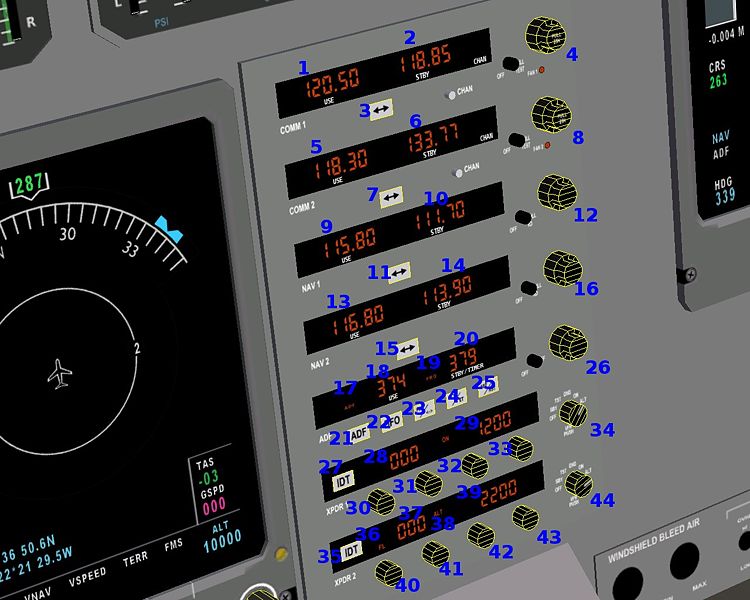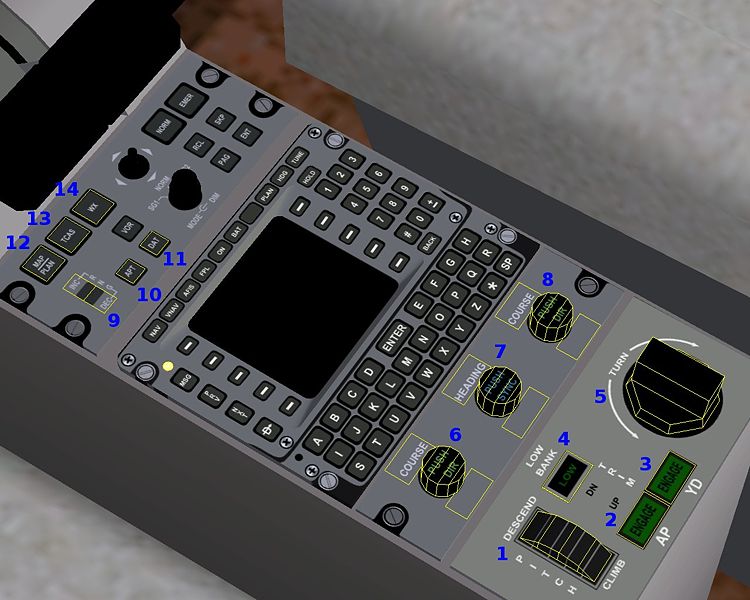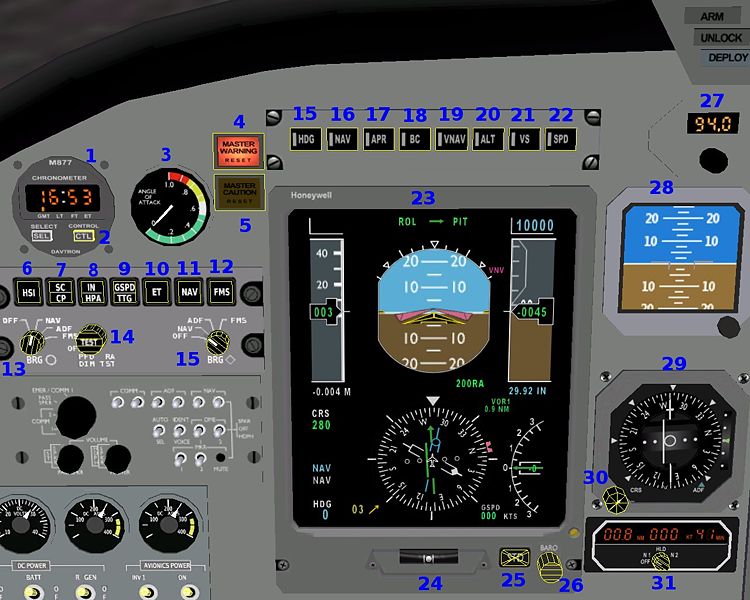Cessna Citation Bravo panel
|
|
- This cockpit is also used in the Learjet 35-A.
Instrumentation
The Citation II Bravo is equipped with a dual Primus 1000 Display and Flight Guidance system with multifunction display. The system enables logical grouping and compact display of the various data required to control the airplane. Data which were previously displayed on various separate instruments can now be electronically grouped together on one cathode ray tube indicator (primary flight display), simplifying and improving instrument crosscheck, and making more data available on a selectable, as needed basis. The airspeed indicators, instantaneous vertical speed indicators, and altimeters which in previous systems displayed their data on separate instruments are now presented on the pilot's and copilot's electronic flight instrument system (EFIS) primary flight displays (PFDs) along with the airplane attitude and navigation information. (source: Original manual)
Panel
B — Radio system for communication and navigation
C — Console
D — Instruments, controls and Primary Flight Display
E — Multifunction Display (MFD), engine gauges and radio
Electric system
1...4 - Enable various exterior lights.
5 - Left engine start button. Push to start engine.
6 - Right engine start button. Push to start engine.
7 - Enable left ignition. Will turn off the engine if disabled.
8 - Enable right ignition. Will turn off the engine if disabled.
9 - Enable power generator on left engine.
10 - Enable power from standby batteries. Only for start-up and emergencies.
11 - Enable power generator on right engine.
12 - Enable standby avionics.
13 - Enable PFD's (pilot and co-pilot) and MFD.
(startup sequence= 10 (on), 12, 13, 7, 8, 5 (wait), 6 (wait), 9, 11, 10 (off), (warning reset), 2, 3)
14 - Voltage of generated current or standby battery
15 & 16 - Current (Amps) balance between generated and used.
Radio
More reading on how to change frequencies and how to use a radio panel is here.
1 — COMM1 main frequency indicator
2 — COMM1 standby frequency indicator
3 — COMM1 swap frequencies button
5 — COMM2 main frequency indicator
6 — COMM2 standby frequency indicator
7 — COMM2 swap frequencies button
9 — NAV1 main frequency indicator
10 — NAV1 standby frequency indicator
11 — NAV1 swap frequencies button
13 — NAV2 main frequency indicator
14 — NAV2 standby frequency indicator
15 — NAV2 swap frequencies button
18 — ADF main frequency indicator
20 — ADF standby frequency indicator
21 — switch modes: ADF or ???
23 — ADF swap frequencies button
Console
1...5 - Autopilot control panel
- 1 - Autopilot pitch control, nose up or down. (some models)
- 2 - Autopilot (dis)engage.
- 3 - Yaw Damper (dis)engage.
- 4 - Enable Low Bank (wide turns) for high speed and/or hight altitude manoeuvring.
- 5 - Banking with autopilot. (some models)
6...8 - Remote instrument controller (RI-553)
- 6 & 8 - Set Course (NAV) of autopilot to current heading.
- 7 - Set Heading bug of autopilot to current heading.
9...14 - MFD controls (MC-800). (some models)
- 9 - Range (scale) of MFD when WX is not selected.
- 10 - Display nearest airports.
- 11 - Display long range NAV information.
- 12 - Display weather (WX) information.
- 13 - Display Traffic Collision Avoidance System (TCAS) information.
- 14 - Display arc heading up (PLAN) or North with airplane at centre (MAP)
Instruments and controls
1 - Clock.
2 - Clock mode button.
3 - Angle of attack gauge.
4 - Power outage warning. Press to acknowledge.
5 - Autopilot turned off due to unexpected manoeuvres warning. Press to acknowledge.
6...15 - Display controller (DC-550)
- 6 - Enable top-of-rose (WX or 90) or full rose (360) display.
- 7 - Enable single cue or cross pointer display. (The UFO sorta thingy in the attitude indicator)
- 8 - Enable altimeter correction in inches of mercury or milibars (HPA)
- 9 - Enable Ground speed (GS) or time-to-go (TTG) display
- 10 - Elapsed time display. (sequence= Reset - Elapsed Time - Stop-Repeat)
- 12 - Display info on FMS (Flight management system) next waypoint.
- 14 - Increase/ decrease decision height while being on ground. The autopilot will shutdown below that altitude.
15...22 - Mode selector panel (MS-560) Autopilot
- 15 - Switch course to Heading (-bug), synchronise heading with current course or switch to Anti-roll.
- 16 - Switch course to NAV (VOR navigation on NAV1). If NAV1 is an ILS it will ignore the set radial.
- 17 - Switch course and declination to catch glidescope on NAV1 (only if NAV1 is an ILS). (some models)
- 18 - Switch course to Back Course. (some models)
- 19 - Switch attitude to Pitch control. (some models)
- 20 - Switch attitude to Altitude or synchronise with current altitude.
- 21 - Switch attitude to Vertical Speed. (some models)
- 22 - Switch speed to AIS bug or synchronise with current speed.
23 - Primus 1000 Primary flight display
24 - Turn and Slip indicator (Inclinometer).
25 - Set altimeter correction to "Standard Pressure" (29.92 inHg) in for Pressure altitude
26 - Adjust altimeter correction, QNH.
27 - N1 max, not variable.
28 - Standby attitude indicator.
29 - Standby horizontal situation indicator (HSI).
30 - Course select knob (not the heading bug).
31 - DME frequency selector
